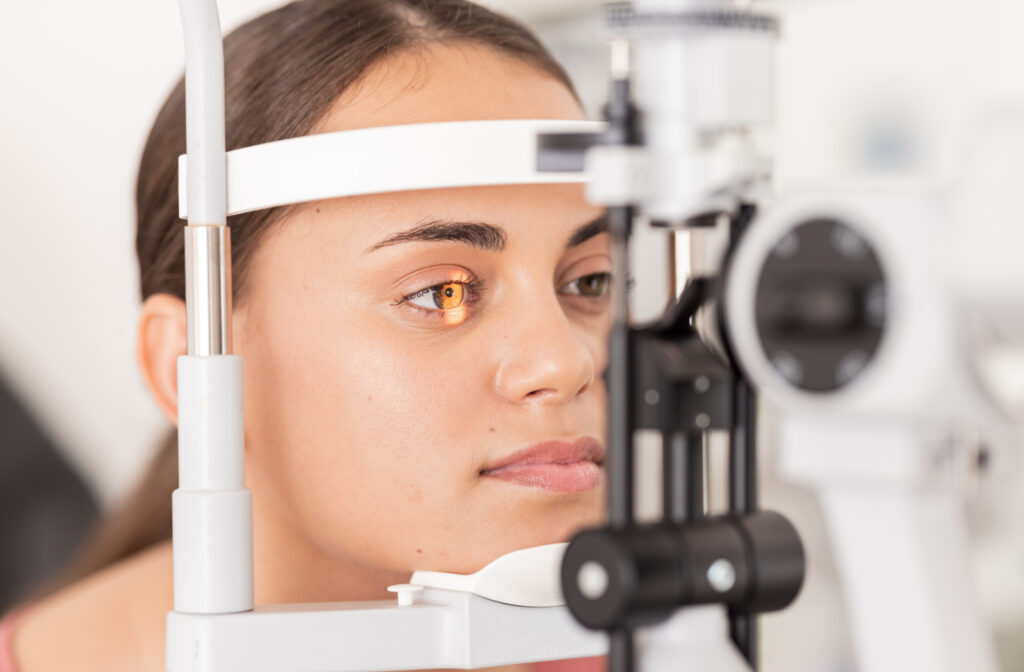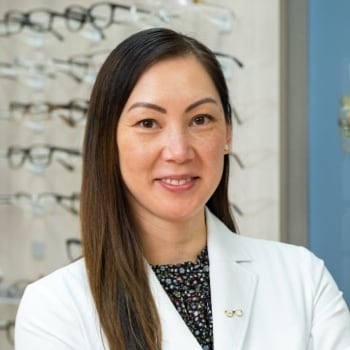Nearsightedness, also known as myopia, is a common refractive error characterized by the inability to view distant objects clearly. Light is not properly focused by the eye’s lens and cornea, making images blurry or distorted.
In most cases, nearsightedness can be corrected using concave prescription eyeglasses or contact lenses. Your optometrist can determine the right prescription for lenses help correct your vision.
Understanding Convex & Concave Lenses
Convex Lenses
Convex lenses are also known as converging lenses because they converge incoming light rays to a point, also known as the focal point. This lens type is thicker at the center and thinner at the edges, bulging outward like a magnifying glass. Convex lenses are commonly used to correct farsightedness or hyperopia, in which individuals can see distant objects clearly but struggle to see close-up.
For those with hyperopia, the eyeball is too short, or the cornea is too flat, so the light hits behind the retina. The convex shape of the lens refracts light directly on the retina, producing clear vision at near distances.
Concave Lenses
Concave lenses, on the other hand, diverge light rays and cause them to spread apart. This lens type is thinner at the center and thicker at the edges, curving inwards like a cave. If you have a strong nearsighted prescription, you may notice that you can’t wear oversized glasses, or the lenses become too thick at the edges.
Concave lenses help correct nearsightedness or myopia, where individuals struggle to see distant objects clearly but can see close-up. When you have myopia, it’s often the result of an elongated eyeball or a cornea that’s too curved, causing light to fall short of the retina. A concave lens helps light reach the retina and correct distance vision.
Corrective Lenses for Nearsightedness
There are various options available to correct nearsightedness with lenses.
Eyeglasses
Glasses are often the first vision correction method patients use, and they function by bending light as it enters the eyes and correcting the focus. They’re available in different frame styles, lens materials, and coatings to improve glare, scratches, and UV protection.
The lenses can be single-vision lenses for one distance or progressive lenses, which gradually blend distance and near vision. Eyeglasses are popular amongst people with myopia as they offer an affordable, non-invasive, and easy-to-use treatment option that can express your personality and style.
Contact Lenses
Unlike eyeglasses, contact lenses sit directly on the eye’s surface, adjusting how light enters the eye to correct its focus. Contact lenses are versatile and polished, making them an attractive choice for many. They can come in several types, including:
- Soft
- Rigid gas-permeable (RGP)
- Extended wear
- Daily disposable
- Ortho-k
Soft lenses, which are generally more comfortable, are the most commonly prescribed. Contact lenses offer greater convenience and a wider field of vision. Contact lenses are a preferred alternative for individuals who play sports or have an active lifestyle where eyeglasses may get in the way.
LASIK Eye Surgery
In recent years, LASIK eye surgery has become a popular option for nearsightedness treatment. LASIK surgery involves creating a small flap in the cornea, reshaping the underlying tissue using an excimer laser, and closing the flap.
The procedure takes approximately 10-15 minutes per eye, and most patients improve their vision immediately. However, LASIK surgery is more invasive than contact lenses or eyeglasses.
Orthokeratology
Orthokeratology (ortho-k), also known as corneal reshaping, refers to the use of specialized lenses worn overnight to reshape the cornea and temporarily correct myopia. Ortho-K lenses reduce the curvature of the cornea, resulting in sharper vision upon removing the lenses in the morning.
The treatment’s results depend on the wear of the lenses and need to be worn regularly. Ortho-k lenses are suitable for individuals with mild to moderate myopia and can help slow down the progression of myopia in children.

Correct Myopia with Lenses
Whether you choose eyeglasses, contact lenses, a combination of both, or surgical options, there are many options to help correct myopia.
If you have existing myopia or suspect you’re nearsighted, give us a call or book an appointment online at our Plainville or Mansfield locations for an eye exam to get an up-to-date prescription and discuss your options for vision correction.





